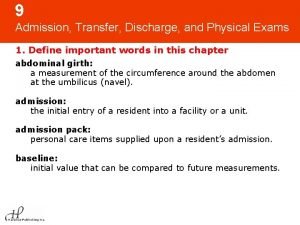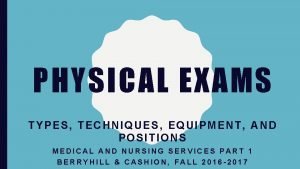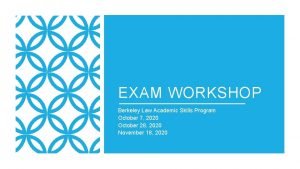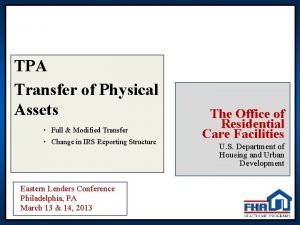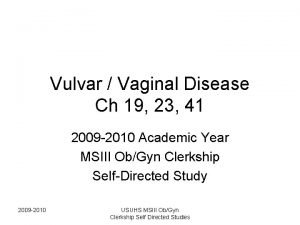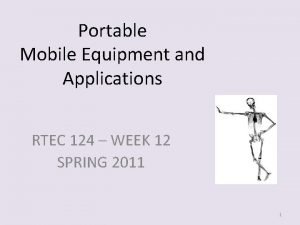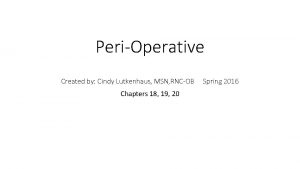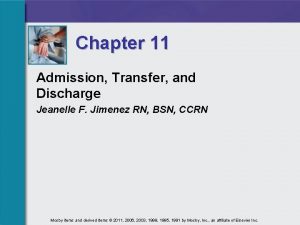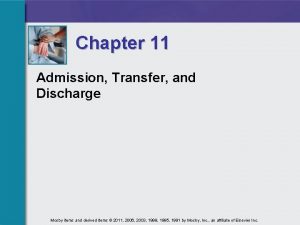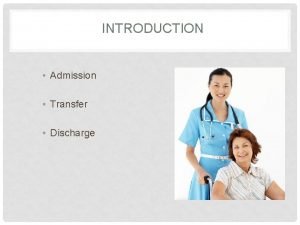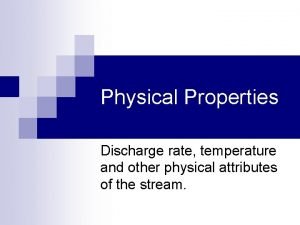9 Admission Transfer Discharge and Physical Exams 1
































































- Slides: 64

9 Admission, Transfer, Discharge, and Physical Exams 1. Define important words in this chapter admission pack personal care items supplied upon a resident's admission. baseline initial value that can be compared to future measurements. bedridden confined to bed.

9 Admission, Transfer, Discharge, and Physical Exams 1. Define important words in this chapter dorsal recumbent position in which a person is flat on her back with knees flexed and slightly separated and her feet flat on the bed. kilogram a unit of mass equal to 1000 grams; one kilogram equals 2. 2 pounds. knee-chest position in which a person is lying on his abdomen with knees pulled up towards the abdomen and with legs separated; arms are pulled up and flexed and the head is turned to one side.

9 Admission, Transfer, Discharge, and Physical Exams 1. Define important words in this chapter lithotomy position in which a person is on her back with her hips at the edge of the exam table; legs are flexed and feet are in padded stirrups. metric system of weights and measures based upon the meter. pound a unit of weight equal to 16 ounces.

9 Admission, Transfer, Discharge, and Physical Exams 2. List factors for families in choosing a facility REMEMBER: Choosing the right facility for a loved one can be a challenging, emotional, and difficult process.

9 Admission, Transfer, Discharge, and Physical Exams 2. List factors for families in choosing a facility Here are some of the questions families might consider when choosing a facility for a loved one: • Do the staff seem courteous and friendly? • Do most of the staff speak the resident's native language? Is an interpreter available? • Are there enough staff members on duty at the facility? What is the ratio of nurses and nursing assistants to residents? How is the facility staffed on evenings and weekends? • Are foul odors present?

9 Admission, Transfer, Discharge, and Physical Exams 2. List factors for families in choosing a facility Questions families might consider when choosing a facility for a loved one (cont'd): • What is the food like at the facility? Is attention paid to individual food preferences? Is a dietician available for meetings? • Are residents up and dressed in the morning? • Do staff interact positively with the residents? • Do staff speak courteously to other staff members? • Do residents look groomed, taken care of, and happy?

9 Admission, Transfer, Discharge, and Physical Exams 2. List factors for families in choosing a facility Questions families might consider when choosing a facility for a loved one (cont'd): • How are residents’ complaints resolved? • Is the facility licensed? • Have the state survey and other inspection results been satisfactory? • Does the facility explain Residents’ Rights? • Are physical, occupational, and speech therapists available? • How often do falls, infections, and pressure ulcers occur?

9 Admission, Transfer, Discharge, and Physical Exams 2. List factors for families in choosing a facility Questions families might consider when choosing a facility for a loved one (cont'd): • Do volunteers work with residents? If so, are their interactions positive? • How involved can the family be in creating the resident's care plan? • Does the facility provide the level of care the resident needs? What about future needs? • Is the environment safe, functional, and homelike?

9 Admission, Transfer, Discharge, and Physical Exams 2. List factors for families in choosing a facility Questions families might consider when choosing a facility for a loved one (cont'd): • Is there an activities department? What kinds of activities are offered? • What are the steps to take if a resident wants to move out of the facility? • What policies does the facility have on advance directives and end-of-life decisions?

9 Admission, Transfer, Discharge, and Physical Exams 2. List factors for families in choosing a facility Think about this question: If you were choosing a facility for a loved one, which factors would matter most to you?

9 Admission, Transfer, Discharge, and Physical Exams 3. Explain the nursing assistant's role in the emotional adjustment of a new resident REMEMBER: Moving into a facility requires a big adjustment. New residents may have been independent for a long time, and they may be moving from their own or a family member’s home. It can be a time of loss and a huge emotional adjustment.

9 Admission, Transfer, Discharge, and Physical Exams Handout 9 -1: Quiz: You are Moving! Your house has been sold and you need to move in with your sister and her family for about six months or more. You are dealing with some difficult situations and may even be staying with them permanently. You don’t know for sure. You will share a room with your niece. Your space is six feet wide by 12 feet long. There is a single bed, a chest of drawers, and a soft chair that you can use. There is also a screen available for your privacy. Decide what you will take with you. You can store anything you don’t take, but you will not have access to any stored items until you move again. Name six things you will take with you. (Seven outfits of clothing count as one item. ) Think of space. All six items must fit into your small room, or in your half of the closet, which is a five foot by three foot space. 1. 2. 3. 4. 5. 6.

9 Admission, Transfer, Discharge, and Physical Exams Handout 9 -1: Quiz: You are Moving! (cont'd) During the first week, your niece is looking at one of your treasured things, and accidentally drops and breaks it. How do you feel? It is now the second week. You have still not received any of your mail, even though you notified the post office to forward it. You mention this to your sister and she says offhandedly, “Oh, I did see some here yesterday. I don’t know where it got to. ” Then she walks out of the room. What is your response?

9 Admission, Transfer, Discharge, and Physical Exams 3. Explain the nursing assistant's role in the emotional adjustment of a new resident After reviewing the Quiz (Handout 9 -1), think about these questions: What did you decide to take, and what are some things that you would be upset about leaving behind? How did you feel when deciding what to take and what to leave behind? How did you feel about the loss of your mail and your sister’s response?

9 Admission, Transfer, Discharge, and Physical Exams 3. Explain the nursing assistant's role in the emotional adjustment of a new resident There are many losses which residents may experience when moving into a facility. Here are some of the reasons why adjusting to life in a facility may be difficult for residents: • Move may have been sudden, due to health reasons. • Resident may have had to leave home and give up personal belongings and beloved pets. • Resident may have had loved ones who have died. • Residents may be experiencing a decline in health and independence.

9 Admission, Transfer, Discharge, and Physical Exams 3. Explain the nursing assistant's role in the emotional adjustment of a new resident REMEMBER: It is important that nursing assistants empathize with residents to help make their adjustment to facility life easier. Sensitivity will make this change easier.

9 Admission, Transfer, Discharge, and Physical Exams 3. Explain the nursing assistant's role in the emotional adjustment of a new resident Remember these guidelines for helping new residents adjust: • Have a positive attitude. • Be tactful. • Communicate clearly. • Show respect for residents’ belongings. • Be responsible.

9 Admission, Transfer, Discharge, and Physical Exams 3. Explain the nursing assistant's role in the emotional adjustment of a new resident Guidelines for helping new residents adjust (cont'd): • Be honest. • Listen to residents. • Pay attention to residents’ wishes. • Respect residents’ privacy. • Be patient and kind.

9 Admission, Transfer, Discharge, and Physical Exams 4. Describe the nursing assistant's role in the admission process Define the following terms: admission pack personal care items supplied upon a resident's admission. baseline initial value that can be compared to future measurements.

9 Admission, Transfer, Discharge, and Physical Exams 4. Describe the nursing assistant's role in the admission process REMEMBER: Admission is often the first time a nursing assistant meets a new resident. When the resident arrives, the NA has the opportunity to give a good first impression of the staff and the facility. He should welcome the new resident in a friendly manner.

9 Admission, Transfer, Discharge, and Physical Exams 4. Describe the nursing assistant's role in the admission process Remember these guidelines for admission: • Wash hands and gather necessary equipment to bring to resident's room. • Prepare the resident's room before he arrives. • Make the bed and open curtains or blinds. • Introduce yourself to resident and call him by his formal name. • Do not rush the process.

9 Admission, Transfer, Discharge, and Physical Exams 4. Describe the nursing assistant's role in the admission process Guidelines for admission (cont'd): • Introduce the new resident to roommate and other residents. • Explain day-to-day life in the facility. • Show resident how to work bed controls. • Make sure call light is close to bed and explain how to use it. • Explain how to work television and phone. • Handle personal items with care and respect.

Admitting a resident Equipment: may include admission paperwork (checklist and inventory form), gloves, and vital signs equipment 1. Identify yourself by name. Identify the resident. Greet the resident by name. 2. Wash your hands. 3. Explain procedure to the resident. Speak clearly, slowly, and directly. Maintain face-to-face contact whenever possible.

Admitting a resident 4. Provide for the resident's privacy with a curtain, screen, or door. Ask the family to step outside until the initial admission process is complete. Show them where they may wait and let them know approximately how long they will have to wait. Tell them where they can get refreshments.

Admitting a resident 5. If instructed, do these things: Measure the resident's height, weight, and vital signs. (Height and weight procedures follow; vitals signs procedures are located in Chapter 13. ) Most facilities require baseline height, weight, and vital sign measurements. Baseline measurements are initial values that can be compared to future measurements. Document on admission form and elsewhere per facility policy. Obtain a urine specimen if required (see Chapter 16). Complete the paperwork. Take an inventory of all of the personal items. Help the resident put personal items away. Label each item if it is facility policy. If the resident has valuables, ask the nurse for instructions. Fill the water pitcher with fresh water. Add ice if requested.

Admitting a resident 6. When the initial portion of the admission is complete, locate the family and let them know they may return to the resident's room. 1. Show the resident the room and bathroom. Explain how to work the bed controls and the call light. Show the resident the lights, telephone, and television controls and how to work them. Give the resident information on menus, dining times, and activity schedules. 8. Introduce the resident to his roommate, if there is one. Introduce other residents and staff. 9. Make resident comfortable. Remove privacy measures. 1. Leave call light within resident's reach. 11. Wash your hands. 12. Be courteous and respectful at all times. Let the resident know when you are leaving. Ask if he needs anything else. 13. Document procedure using facility guidelines.

9 Admission, Transfer, Discharge, and Physical Exams 4. Describe the nursing assistant's role in the admission process Define the following terms: pound a unit of weight equal to 16 ounces. metric system of weights and measures based upon the meter. bedridden confined to bed. kilogram a unit of mass equal to 1000 grams; one kilogram equals 2. 2 pounds.

9 Admission, Transfer, Discharge, and Physical Exams 4. Describe the nursing assistant's role in the admission process Think about this question: Why should any change in a resident's weight be reported right away?

Measuring and recording weight of an ambulatory resident Equipment: standing/upright scale, pen and paper 1. Identify yourself by name. Identify the resident. Greet the resident by name. 2. Wash your hands. 3. Explain procedure to the resident. Speak clearly, slowly, and directly. Maintain face-to-face contact whenever possible. 1. Provide for the resident's privacy with a curtain, screen, or door. 5. Make sure resident is wearing non-skid shoes before walking to scale. 6. Start with the scale balanced at zero before weighing the resident. If you do not know how to balance the scale, ask the nurse. 7. Help the resident step onto the center of the scale, facing the scale. Be sure she is not holding, touching, or leaning against anything.

Measuring and recording weight of an ambulatory resident 8. Determine resident's weight. This is done by balancing the scale by making the balance bar level. Move the small and large weight indicators until the bar balances. Read the two numbers shown (on the small and large weight indicators) when the bar is balanced. Add these two numbers together. This is the resident's weight.

Measuring and recording weight of an ambulatory resident 9. Help the resident to safely step off the scale before recording weight. 10. Remove privacy measures. 11. Leave call light within resident's reach. 12. Wash your hands. 13. Be courteous and respectful at all times. 14. Report any changes in the resident to the nurse. Record resident’s weight. Document procedure using facility guidelines.

Measuring and recording weight of a bedridden resident Equipment: scale, pen and paper Have another co-worker assist you. 1. Identify yourself by name. Identify the resident. Greet the resident by name. 2. Wash your hands. 3. Explain procedure to the resident. Speak clearly, slowly, and directly. Maintain face-to-face contact whenever possible. 1. Provide for the resident's privacy with a curtain, screen, or door. 5. Adjust the bed to a safe level, usually waist high. Lock the bed wheels. 6. Start with the scale balanced at zero before weighing the resident. If you do not know how to balance the scale, ask the nurse. 7. Examine the sling, straps, chains, and/or pad for any damage. Do not use the scale if you find damage.

Measuring and recording weight of a bedridden resident 1. Turn linen down so that it is off the resident. 9. Have the resident turn toward you. If the resident cannot do this, you must turn him toward you (see Chapter 11). Be sure the resident cannot roll off the bed. If flat pad scale is used, slide resident onto pad using a helper. If a sling is used, remove from the scale and place underneath the resident without wrinkling it. 10. When using a sling, turn the resident back on his back and straighten sling.

Measuring and recording weight of a bedridden resident 11. Attach the sling to the scale or, if using a flat pad scale, position resident securely on the pad. 1. Check the straps or other connectors, and raise the sling or the pad until the resident is clear of the bed. With some scales, you can keep the resident directly over the bed while weighing him. With others, you have to move the scale away from the bed. Secure the resident before moving the scale. 13. For digital scales, turn them on and note reading. For other scales, move the weights until you get a reading. Note the weight. 1. Lower the resident back down on the bed. If using a sling, turn resident to both sides to remove the sling. If using a pad scale, carefully slide the resident back onto the bed. 2. Make resident comfortable. Replace bed linens.

Measuring and recording weight of a bedridden resident 16. Return bed to lowest position. Remove privacy measures. 17. Leave call light within resident's reach. 18. Wash your hands. 19. Be courteous and respectful at all times. 20. Report any changes in the resident to the nurse. Document procedure using facility guidelines.

Measuring and recording height of an ambulatory resident Equipment: standing/upright scale, pen and paper 1. Identify yourself by name. Identify the resident. Greet the resident by name. 2. Wash your hands. 3. Explain procedure to the resident. Speak clearly, slowly, and directly. Maintain face-to-face contact whenever possible. 4. Provide for the resident's privacy with a curtain, screen, or door.

Measuring and recording height of an ambulatory resident 1. Make sure the resident is wearing nonskid shoes that are fastened before walking to scale. 2. Help the resident to step onto scale and then face away from the scale. 3. Ask the resident to stand straight if possible. Help as needed. 4. Pull up measuring rod from back of scale. Gently lower measuring rod until it rests flat on the resident's head. 5. Determine resident's height.

Measuring and recording height of an ambulatory resident 1. Help the resident off the scale. Make sure the measuring rod does not hit resident in the head. 2. Remove privacy measures. 12. Leave call light within resident's reach. 13. Wash your hands. 1. Be courteous and respectful at all times. 2. Report any changes in the resident to the nurse. Record the resident’s height. Document procedure using facility guidelines.

Measuring and recording height of a bedridden resident Equipment: tape measure, pencil, pen and paper 1. Identify yourself by name. Identify the resident. Greet the resident by name. 2. Wash your hands. 3. Explain procedure to the resident. Speak clearly, slowly, and directly. Maintain face-to-face contact whenever possible. 4. Provide for the resident's privacy with a curtain, screen, or door.

Measuring and recording height of a bedridden resident 5. Adjust the bed to a safe level, usually waist high. Lock the bed wheels. 6. Turn linen down so it is off the resident. 7. Position resident lying straight in the supine (back) position. Be sure the bed sheet is smooth underneath the resident. 8. Using a pencil, make a small mark on the bottom sheet (or bath blanket that is underneath the resident) at the top of the resident's head.

Measuring and recording height of a bedridden resident 9. Make another pencil mark at the resident's heel on the bottom sheet (or bath blanket that is underneath the resident). 1. Using the tape measure, measure the area between the pencil marks. This is the resident's height. 2. Make resident comfortable. Replace bed linen. 3. Return bed to lowest position. Remove privacy measures.

Measuring and recording height of a bedridden resident 13. Leave call light within resident’s reach. 14. Wash your hands. 15. Be courteous and respectful at all times. 16. Report any changes in the resident to the nurse. Document procedure using facility guidelines.

9 Admission, Transfer, Discharge, and Physical Exams Measuring abdominal girth (Handout 9 -2) Measuring abdominal girth Equipment: measuring tape, pen and paper to record your findings 1. Identify yourself by name. Identify the resident. Greet the resident by name. 2. Wash your hands. 3. Explain procedure to the resident. Speak clearly, slowly, and directly. Maintain face-to-face contact whenever possible. 4. Provide for the resident's privacy with a curtain, screen, or door. 5. Adjust the bed to a safe level, usually waist high. Lock the bed wheels. 6. Position resident lying straight in the supine (back) position.

9 Admission, Transfer, Discharge, and Physical Exams Measuring abdominal girth (Handout 9 -2) 7. Turn linen down and raise gown or top enough to expose only the abdomen. Keep all areas covered that do not need to be exposed. Promote resident's right to dignity and privacy. 8. Gently wrap measuring tape around the resident's abdomen at the level of the navel.

9 Admission, Transfer, Discharge, and Physical Exams Measuring abdominal girth (Handout 9 -2) 9. Read the number where the ends of the tape meet. 10. Carefully remove the tape measure. Record abdominal girth measurement. 11. Make resident comfortable. Replace clothing and bed linen. 12. Return bed to lowest position. Remove privacy measures.

9 Admission, Transfer, Discharge, and Physical Exams Measuring abdominal girth (Handout 9 -2) 13. Leave call light within resident's reach. 14. Wash your hands. 15. Be courteous and respectful at all times. 16. Report any changes in the resident to the nurse. Document procedure using facility guidelines.

9 Admission, Transfer, Discharge, and Physical Exams 5. Explain the nursing assistant's role during an in-house transfer of a resident REMEMBER: Transfers can be difficult for residents. Nursing assistants can help by trying to make transfers as smooth as possible.

9 Admission, Transfer, Discharge, and Physical Exams 5. Explain the nursing assistant's role during an in-house transfer of a resident Remember these important points about transfers: • The resident should be informed as soon as possible of the transfer. • The NA should pack the resident’s personal items carefully. • The NA should know the method of transfer and plan the move. • The NA should introduce the resident to everyone at the new unit. • When leaving the room, the NA should report to the nurse in charge of the resident.

Transferring a resident to a new room Equipment: may include wheelchair or stretcher, cart for belongings, all of the resident's packed personal items 1. Identify yourself by name. Identify the resident. Greet the resident by name. 2. Wash your hands. 1. Explain procedure to the resident. Speak clearly, slowly, and directly. Maintain face-to-face contact whenever possible. 4. Provide for the resident's privacy with a curtain, screen, or door. 5. Collect the items to be moved onto the cart, and ask another staff member to help take them to the new location. 6. Lock wheelchair or stretcher wheels. Help the resident into the wheelchair or onto the stretcher. Take him or her to the proper area. 7. Introduce new residents and staff.

Transferring a resident to a new room 8. Provide for the resident’s privacy with a curtain, screen, or door. 9. Lock wheelchair or stretcher wheels. Transfer the resident to the new bed if needed. 10. Unpack all belongings. Help the resident put personal items away. 11. Make resident comfortable. Remove privacy measures. 12. Leave call light within resident's reach. 1. Wash your hands. 2. Be courteous and respectful at all times. 15. Report to the charge nurse when the transfer is complete. Report any changes in the resident to the nurse. Document procedure using facility guidelines.

9 Admission, Transfer, Discharge, and Physical Exams 6. Explain the nursing assistant's role in the discharge of a resident REMEMBER: A discharge is official after the doctor writes the discharge order that releases the resident to leave.

9 Admission, Transfer, Discharge, and Physical Exams 6. Explain the nursing assistant's role in the discharge of a resident Remember these nursing assistant responsibilities during the discharge of a resident: • Collect resident's belongings and pack them carefully. • Be positive and reassuring. • Know if the resident will need a wheelchair or stretcher.

9 Admission, Transfer, Discharge, and Physical Exams 6. Explain the nursing assistant's role in the discharge of a resident Think about this question: Why is the nursing assistant responsible for the resident until she is safely in the vehicle, with the vehicle’s doors closed?

Discharging a resident Equipment: may include a wheelchair or stretcher, cart for belongings, the discharge paperwork, including the inventory list done on admission, all of the resident's personal care items, vital signs equipment 1. Identify yourself by name. Identify the resident. Greet the resident by name. 1. Wash your hands. 3. Explain procedure to the resident. Speak clearly, slowly, and directly. Maintain face-to-face contact whenever possible. 1. Provide for the resident's privacy with a curtain, screen, or door. 2. Measure the resident’s vital signs. 6. Compare the inventory list to the items being packed. Ask the resident to sign if all items are there.

Discharging a resident 7. Carefully put the items to be taken onto the cart, and ask another staff member to help transport items to the pick-up area. 8. Help the resident dress in clothing of his choice. Make sure the nurse has removed all dressings, IVs and tubes that need to be removed prior to discharge. 9. Lock wheelchair or stretcher wheels. Help her safely into the wheelchair or onto the stretcher (Chapter 11) if used. 10. Help the resident say her goodbyes to other residents and the staff. 11. Take resident to the pick-up area. Lock wheelchair or stretcher wheels. Help the resident into the vehicle. Transfer personal items into the vehicle. 1. Say goodbye to the resident. You are responsible for the resident until he or she is safely in the vehicle and the door is closed.

Discharging a resident 13. Wash your hands. 14. Document procedure using facility guidelines.

9 Admission, Transfer, Discharge, and Physical Exams 7. Describe the nursing assistant's role during physical exams REMEMBER: Physical exams can be embarrassing and uncomfortable. Part of a nursing assistant’s role during an exam is to help residents by listening to them, talking to them, or holding their hands.

9 Admission, Transfer, Discharge, and Physical Exams 7. Describe the nursing assistant's role during physical exams Nursing assistants may be responsible for gathering equipment for the nurse or doctor before a physical exam: • Sphygmomanometer • Stethoscope • Alcohol wipes • Flashlight • Thermometer • Tongue depressor • Eye chart • Tuning fork

9 Admission, Transfer, Discharge, and Physical Exams 7. Describe the nursing assistant's role during physical exams Equipment for a physical exam (cont'd): • Reflex hammer • Otoscope • Ophthalmoscope • Specimen containers • Lubricant • Hemoccult card • Vaginal speculum • Gloves • Drape

9 Admission, Transfer, Discharge, and Physical Exams 7. Describe the nursing assistant's role during physical exams Define the following terms: dorsal recumbent position in which a person is flat on her back with knees flexed and slightly separated and her feet flat on the bed. lithotomy position in which a person is on her back with her hips at the edge of the exam table; legs are flexed and feet are in padded stirrups. knee-chest position in which a person is lying on his abdomen with knees pulled up towards the abdomen and with legs separated; arms are pulled up and flexed and the head is turned to one side.

9 Admission, Transfer, Discharge, and Physical Exams Transparency 9 -1: Body Positions for Exams

9 Admission, Transfer, Discharge, and Physical Exams 7. Describe the nursing assistant's role during physical exams REMEMBER: Body positions used for exams may be uncomfortable or embarrassing for residents. The nursing assistant can help by explaining why the position is needed and how long the resident can expect to stay in the position. The NA can also help by ensuring that the resident’s privacy is protected throughout the exam.

9 Admission, Transfer, Discharge, and Physical Exams 7. Describe the nursing assistant's role during physical exams Remember these guidelines for assisting during an exam: • Wash hands before and after exam. • Follow Standard Precautions. • Collect and label specimens as needed. • Provide privacy measures. • Listen to and reassure resident. • Follow doctor’s or nurse’s instructions. • Make sure resident does not fall.

9 Admission, Transfer, Discharge, and Physical Exams 7. Describe the nursing assistant's role during physical exams Guidelines for assisting during an exam (cont’d): • Provide light for doctor or nurse. • Put instruments in proper place and hand them to doctor or nurse. • Help resident get cleaned up and dressed after exam. Dispose of trash and bring equipment to proper area. Label and transport specimens as needed.
 Chapter 9 admission transfer discharge and physical exams
Chapter 9 admission transfer discharge and physical exams Chapter 9 admission transfer discharge and physical exams
Chapter 9 admission transfer discharge and physical exams Chapter 11 admission transfer and discharge
Chapter 11 admission transfer and discharge Chapter 11 admission transfer and discharge
Chapter 11 admission transfer and discharge Admission procedure in hospital
Admission procedure in hospital Physical exam instruments
Physical exam instruments Ucla transfer requirements
Ucla transfer requirements Waves are repeating disturbances that transfer
Waves are repeating disturbances that transfer 410a charge chart
410a charge chart Egress corridor definition
Egress corridor definition Exit exit access and exit discharge
Exit exit access and exit discharge Nipple discharge color
Nipple discharge color Poem on exams
Poem on exams Maarit haikonen
Maarit haikonen Adit course providers
Adit course providers Comprehensive exams
Comprehensive exams Prayer to st joseph of cupertino before exam
Prayer to st joseph of cupertino before exam Prayers before test
Prayers before test New york state teacher certification exams
New york state teacher certification exams Exam examples of
Exam examples of Berkeley law exam
Berkeley law exam English official exams
English official exams John is generally pleasant
John is generally pleasant Complete the sentences if i pass my exams
Complete the sentences if i pass my exams Byod exams
Byod exams Strategic staffing definition
Strategic staffing definition Purdue physics 172 past exams
Purdue physics 172 past exams Biometric assisted proctoring
Biometric assisted proctoring Cambridge exam day checklist
Cambridge exam day checklist Human resource management question papers with answers
Human resource management question papers with answers Ku leuven exam results
Ku leuven exam results Brunel exam
Brunel exam Exams actesting
Exams actesting Are the keystone exams mandatory
Are the keystone exams mandatory Vce physics resources
Vce physics resources Rcpch exams
Rcpch exams University of auckland aegrotat
University of auckland aegrotat Indiana teaching license test
Indiana teaching license test Derived grade exams
Derived grade exams Yale placement tests
Yale placement tests Decas exams
Decas exams Paragraph about exams
Paragraph about exams Myp cards
Myp cards Ib history exams
Ib history exams Juma ki rakat
Juma ki rakat Stanag 6001 tests download
Stanag 6001 tests download Www.awinfosys.com/eassessment/exams sample.htm
Www.awinfosys.com/eassessment/exams sample.htm Aspec exams
Aspec exams Modified tpa
Modified tpa Price fences marketing
Price fences marketing What is physical fitness test in mapeh
What is physical fitness test in mapeh Serosanguineous exudate
Serosanguineous exudate Yellow cottage cheese discharge
Yellow cottage cheese discharge Cystitiis
Cystitiis Lochia rubra
Lochia rubra Trichomoniasis discharge pictures female
Trichomoniasis discharge pictures female Oral sex
Oral sex Discharge messages safewards
Discharge messages safewards Cnidocyte
Cnidocyte جريد
جريد Nematocysts
Nematocysts Aldrete score for discharge
Aldrete score for discharge Modified aldrete score
Modified aldrete score What does uti discharge look like
What does uti discharge look like Partial discharge in medium voltage switchgear
Partial discharge in medium voltage switchgear

